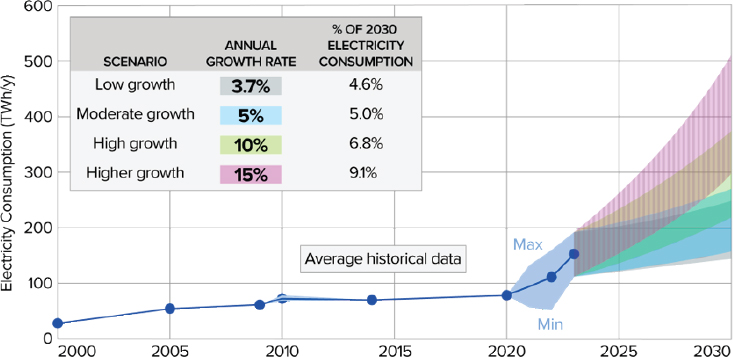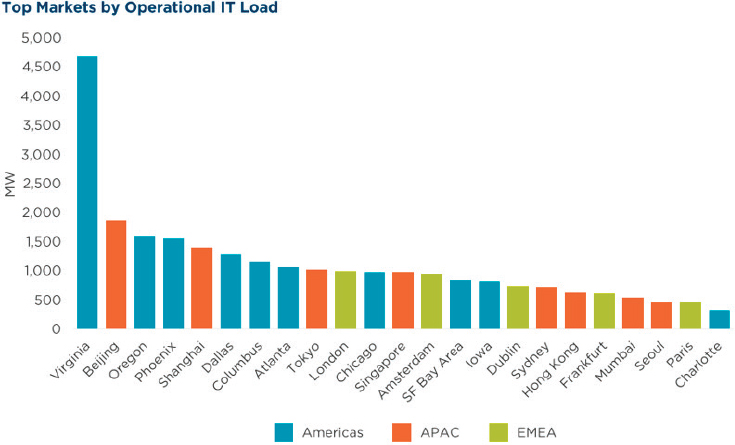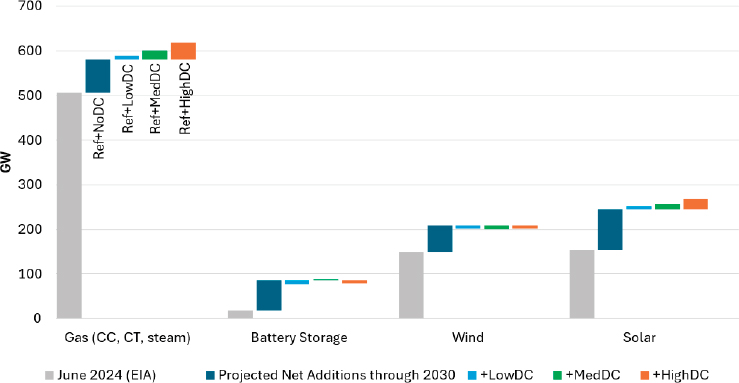Implications of Artificial Intelligence–Related Data Center Electricity Use and Emissions: Proceedings of a Workshop (2025)
Chapter: 2 Context on Data Center Energy Use and Impacts
2
Context on Data Center Energy Use and Impacts
Two keynote speakers reviewed emerging data to provide context on data center energy use and impacts. Arman Shehabi, Lawrence Berkeley National Laboratory (LBNL), discussed how data center energy use has evolved over the past two decades and considered how the rise of highly specialized hardware and artificial intelligence (AI) might create new opportunities for efficiency and decarbonization. Thomas Wilson, Electric Power Research Institute (EPRI), shared highlights from EPRI projections of data center power use and grid impacts and discussed how more flexible data center operations could help to accelerate AI development while minimizing costs, lowering carbon emissions, and enhancing system reliability.
THE EVOLUTION OF DATA CENTER ENERGY USE
The adoption of AI applications across multiple fields could bring significant impacts for data center energy use and the electric utilities that are responsible for supplying power across the United States. To provide context for the current trends in this space, Shehabi described a series of three reports documenting how data centers and their energy demands have evolved over the past 25 years. LBNL’s bottom-up, continually evolving models provide a basis for these analyses by compiling available information about the number of servers in operation and the equipment and architectures being used for storage, networking, cooling, and other facets of data center operations to estimate energy use. The
resulting reports, published in 2007,1 2016,2 and 2024,3 serve as a resource for decision makers regarding the factors that are driving the energy demands of data centers and their environmental impacts.4
Congress first requested that LBNL analyze data center electricity use and opportunities to mitigate this trajectory in energy demand in the early 2000s, driven by a concern that, if current trends at the time were to continue, data centers could account for one-third of all U.S. energy use by 2030.5 As the 2007 report documented, data centers’ electricity use had doubled from 2000–2005.6 Shehabi explained that this large energy demand was due to an increased buildout of data centers but also in part to operational inefficiencies; during the initial years of the dot-com expansion, data centers were built with off-the-shelf equipment, cooling methods were not optimized for efficiency, and idle servers drew large amounts of power. By the 2010s, as documented in the 2016 report, data centers were much larger, but their energy demands remained relatively flat thanks to the adoption of more energy-efficient custom equipment, advancements in cooling technologies, and a shift toward cloud services.7
Following these periods of rising and then plateauing energy demand, recent years have seen another turning point characterized by a sharp rise in data center energy demands (Figure 2-1). This shift can be largely attributed to the growth of AI, which has increased the need for graphics processing unit (GPU) accelerators, increased power draws from servers, and spurred a shift from smaller data centers to clustered and hyperscale ones. These factors combined to essentially triple energy
___________________
1 R. Brown, E. Masanet, B. Norman, et al., 2008, Report to Congress on Server and Data Center Energy Efficiency: Public Law 109-431, Lawrence Berkeley National Laboratory, https://escholarship.org/uc/item/74g2r0vg.
2 A. Shehabi, S. Smith, D. Sartor, et al., 2016, United States Data Center Energy Usage Report, LBNL-1005775, Lawrence Berkeley National Laboratory, https://www.iea-4e.org/wp-content/uploads/publications/2016/06/05j_-_LBNL_-_US_Data_Centres_Energy_USe.pdf.
3 A. Shehabi, S.J. Smith, A. Hubbard, et al., 2024, 2024 United States Data Center Energy Usage Report, LBNL-2001637, Lawrence Berkeley National Laboratory, https://eta-publications.lbl.gov/sites/default/files/2024-12/lbnl-2024-united-states-data-center-energy-usage-report.pdf.
4 A. Shehabi, S.J. Smith, E. Masanet, and J. Koomey, 2018, “Data Center Growth in the United States: Decoupling the Demand for Services from Electricity Use,” Environmental Research Letters 13(12):124030, https://doi.org/10.1088/1748-9326/aaec9c.
5 E. Masanet, A. Shehabi, N. Lei, S. Smith, and J. Koomey, 2020, “Recalibrating Global Data Center Energy-Use Estimates,” Science 367(6481):984–986, https://doi.org/10.1126/science.aba3758.
6 J.G. Koomey, 2008, “Worldwide Electricity Used in Data Centers,” Environmental Research Letters 3(3):034008, https://doi.org/10.1088/1748-9326/3/3/034008.
7 A. Shehabi, S. Smith, D. Sartor, et al., 2016, United States Data Center Energy Usage Report, LBNL-1005775, Lawrence Berkeley National Laboratory, https://www.iea-4e.org/wp-content/uploads/publications/2016/06/05j_-_LBNL_-_US_Data_Centres_Energy_USe.pdf.

SOURCE: Arman Shehabi, Lawrence Berkeley National Laboratory, presentation to the workshop, November 12, 2024.
demand between 2017 and 2023—and may triple it again in the next few years,8 Shehabi said.
Developments in data center operations occur alongside and interact with broader societal trends in the economy and the ways in which people use technology. Shehabi pointed out that the plateau in data center energy use that was documented in the 2016 report began around the time of the 2008 recession, while the rapid growth that has occurred since 2017 was driven in part by the growth of social media, which further accelerated during the COVID-19 pandemic. While early efficiency innovations offset data centers’ energy impact, their rapid growth soon outpaced both efficiency gains and clean energy expansion, leading to rising energy demand and emissions.
___________________
8 R. Miller, 2024, “DOE Study: AI Boom Breeds Localized Energy Constraints, But Grid Can Meet Long-Term Demand,” Data Center Frontier, https://www.datacenterfrontier.com/energy/article/55019791/doe-study-ai-boom-breeds-localized-energy-constraints-but-grid-can-meet-long-term-demand.
Models can be useful in understanding drivers of past trends and projecting future ones, but Shehabi cautioned that models are not perfect, the future remains uncertain, and many factors could affect what happens next. Data center growth could flatten again after this latest acceleration, or it may continue to grow as AI improves and constraints, such as chip and energy availability, are removed. Shehabi also noted that the growth of AI data centers is occurring in parallel with a broader economy-wide expansion in electricity demand propelled by trends toward electrification in transportation and onshoring of manufacturing, and suggested that AI data centers could serve as a testbed and resource to help drive innovations that contribute to responsible growth in energy use and decarbonization goals. “I think data centers are, in many ways, a great first type of industry for us to figure out how we can deal with this type of growth that we are going to have to deal with many times over,” Shehabi said. “Data centers relative to other industrial loads are quite flexible in their location and in how they can adjust their power. They’re innovative industrial players, and they have interests in decarbonization.” In light of both the potential opportunities and the uncertainties that lie ahead, Shehabi underscored the importance of continuing to study data centers’ energy use and their impact on the grid.
An open question-and-answer session followed Shehabi’s presentation. Trisha Ray, Atlantic Council, asked if LBNL’s modeling approaches accounted for climate events such as droughts and flooding. Shehabi replied that modelers do account for how factors such as droughts and general warming might affect cooling systems; however, he noted that it is challenging to project more than a few years into the future.
Andrew Chien, University of Chicago, commented that there remain many barriers to creating accurate modeling estimates and forecasts and informing greater coordination around investment in power, transmission, and data center infrastructure. Shehabi agreed and noted that one of the biggest challenges has been the lack of transparency in data center energy use and growth compared to other industries. If that information could be securely shared, the models’ accuracy would improve. Sarah Medepalli, Noblis, asked if any intergovernmental or research-based collaborative efforts were tasked with addressing the increased energy needs associated with AI. Shehabi replied that there are at least a few such efforts that are in their early stages, citing the Congressional AI Task Force and the Department of Energy’s (DOE’s) AI Task Force as two examples.
Andrew Grimshaw, Lancium and University of Virginia, noted that when electricity costs and the cost of carbon emissions are low, companies will use as much energy as they need to accomplish their performance goals. While efficiency is seen as a good thing, he asked whether increasing energy use should always be perceived as a negative outcome.
Shehabi noted that electrification and growing the grid to aid decarbonization efforts is a widely embraced goal but emphasized the need to make that growth clean and sustainable and avoid reverting to fossil fuels. He suggested that data centers can lead the way to enabling broader clean energy buildouts that will ultimately support the power needs of other industries. Kurt Straif, Boston College, asked how to balance increased electricity use with the urgent need to reduce carbon emissions, and Shehabi replied that data center growth offers an opportunity to accelerate decarbonization, since data centers are an industry that is already electrified and poised to drive strategic grid growth, potentially creating a path to more clean energy.
Tracy Wilson, OTH Analysis LLC, asked how chip design or quantum computing advances could influence future growth, and Shehabi agreed that such innovations could be game changers. However, while chips are increasingly computationally efficient, he emphasized that increased efficiency does not necessarily equate to reduced energy needs given the seemingly unlimited demand for computation. “Being able to compute more with the same amount of power just allows us to compute more,” he stated.
Prakhar Mehrotra, Blackstone, asked about the relative influence of inference versus training9 in driving the energy use trends Shehabi described in the late 2000s and early 2010s and looking toward the future. Shehabi reiterated that the flat demand seen during that period was driven by the economic recession combined with new efficiencies such as those enabled by the shift to cloud computing. Looking to the future, he said that a shift of a similar magnitude in the energy use trajectory would require a similarly groundbreaking innovation that fundamentally changes how data centers operate.
PROJECTED DATA CENTER POWER USE AND IMPLICATIONS FOR THE GRID
Wilson highlighted findings from several EPRI reports and initiatives focused on the intersection of U.S. energy systems and data centers over the coming years. The 2024 report Powering Intelligence: Analyzing Artificial Intelligence and Data Center Energy Consumption10 examines how
___________________
9 Inference is the use of an AI model to generate outputs such as conclusions or predictions; training is the process of teaching an AI model to make inferences by recognizing patterns in data.
10 Electric Power Research Institute (EPRI), 2024, “Powering Intelligence: Analyzing Artificial Intelligence and Data Center Energy Consumption,” https://www.epri.com/research/products/3002028905.

SOURCE: Tom Wilson, EPRI, presentation to the workshop, November 12, 2024.
data centers drive electricity demand, opportunities for efficiency gains or growth limits, and projections for future demand. The report outlines four scenarios for data center power demands through 2030 (Figure 2-2), while acknowledging the wide range of uncertainties involved in making these projections. To complement and expand upon national-level estimates, Wilson also stressed the importance of the rapid shift to larger data centers and potentially significant implications for local and regional grids. Companies consider a variety of factors when determining where to site data centers, including power availability, the presence of a local technology market, fiber connectivity, local taxes and energy costs, land availability, and access to low-carbon energy options. While data centers were historically highly concentrated in a few locations, Wilson noted that they have become more geographically distributed in recent years—with Virginia home to by far the largest concentration, followed by Beijing and emerging locations such as Oregon and Phoenix (Figure 2-3).11
In another report, a survey of representatives from 25 electric utility operators offers insights on the volume and nature of data center interconnection requests utilities were seeing in the summer of 2024. Respondents reported that companies are requesting larger interconnects,
___________________
11 J. Albers, V. Dahiya, A. Fraym, and J. Howe, 2024, 2024 Global Data Center Market Comparison, Cushman & Wakefield, https://www.cushmanwakefield.com/en/insights/global-data-center-market-comparison.

NOTE: APAC, Asia-Pacific; EMEA, Europe, the Middle East, and Africa.
SOURCES: Tom Wilson, EPRI, presentation to the workshop, November 12, 2024, from Cushman & Wakefield, “2024 Global Data Center Market Comparison,” https://www.cushmanwakefield.com/en/insights/global-data-center-market-comparison.
with 60 percent seeing requests for single sites of 500 MW or larger and 48 percent seeing requests for 1000 MW or larger.12 Data centers are also expected to account for an increasingly large fraction of system peak demand. Even acknowledging that there are many duplicated requests for interconnection, respondents reported that the magnitude of requests is massive, exceeding current system peak demands for 5 of the 22 respondents and exceeding by 2.5-fold the current system peak demand of 1 respondent.
Another report, Powering Data Centers: U.S. Energy System and Emissions Impacts of Growing Loads, examines the implications of data center load growth for power generation and emissions, considering both a current policy scenario and a future where the United States is committed to achieving net-zero emissions by 2050. In addition to load growth from data centers, the study considered increased loads from electrification
___________________
12 EPRI, 2024, “Utility Experiences and Trends Regarding Data Centers: 2024 Survey,” https://www.epri.com/research/products/000000003002030643.

SOURCE: Tom Wilson, EPRI, presentation to the workshop, November 12, 2024.
and industrial on-shoring.13 The report’s projections of net additions to energy generation and storage capacity through 2030 under different load growth scenarios suggest that additional natural gas and solar generation capacity will provide most of the new capacity, with wind and battery storage accounting for a lower share (Figure 2-4), assuming data centers focused on least-cost electricity supply. Wilson noted that if data center owners achieved voluntary goals, such as hourly matching of their load with carbon-free energy, emissions impacts would be reduced as storage technologies and carbon-free resources, such as nuclear, play larger roles.
Wilson also pointed out that if data centers can operate flexibly (either through computational flexibility or by utilizing onsite storage or generation resources in times of grid stress), grid buildout could be reduced, and it is possible to meet more of these demands with renewable energy and avoid additional fossil fuel use. However, there are many questions to resolve in order to realize that vision of flexible data centers. To advance work in this area, EPRI recently launched the Data Center Flexible Load Initiative (DCFlex) in collaboration with a large group of technology
___________________
13 EPRI, 2024, “Powering Data Centers: U.S. Energy System and Emissions Impacts of Growing Loads,” white paper, https://www.epri.com/research/products/000000003002031198.
industry stakeholders, data center developers, equipment suppliers, and electric power companies, which include utilities, independent power producers, independent system operators, and regional transmission organizations. The initiative aims to create reference architectures for flexible data centers that can become grid enhancers, identify transformative utility programs and new market structures that incentivize data center flexibility, and design a flexibility framework with a standardized taxonomy for grid-data center communications and operations to avoid reliability challenges and system failures.14
Following Wilson’s remarks, participants delved deeper into issues around modeling, flexibility, and costs. Chien asked about the emissions connected with each of the capacity growth scenarios EPRI modeled, and Wilson stated that the numbers are in the report.15 They generally suggest that emissions will rise as data center demand increases through about 2030, but this bump will be followed by a contraction by around 2035 as technological advancements come online to create a cleaner grid. How this plays out depends on the policies in place to incentivize renewables or flexibility, limit increased coal or gas generation, and mitigate emissions impacts to communities hosting data centers, he added. Shehabi asked if data centers are actually using the increased capacity utilities are bringing online now, or whether it is being purchased with the idea that it would be used in the future. Wilson replied that the answer is unclear, but given that there are essentially waiting lists for GPU time, data centers probably are using it as soon as they can get it. However, he noted that that could change as capacity ramps up, and ramp-up of power demands may depend on data centers’ different ownership models.
George Kamiya, an independent expert, asked what utility administrators can do to leverage data center load as a flexible resource. Wilson replied that computational flexibility can facilitate geographic or temporal redispatching of workloads. While onsite backup generation can create additional flexibility when grid reliability is a concern, he noted that there are air quality impacts and operational limitations if diesel-powered generators are used for this. He also noted that arbitrage over limited variation in electricity prices is unlikely to incentivize change, but shorter connection or in-service times create strong incentives for data centers to build in flexibility. Giri Iyer, Sentient Energy, asked what innovations can improve solar and wind dispatchability and affordability, and Wilson replied that pairing batteries with solar can shift generation across hours in the day, but that did not work as well for wind, generally speaking. Will
___________________
14 EPRI, n.d., “DCFlex,” https://msites.epri.com/dcflex, accessed April 21, 2025.
15 EPRI, 2024, “Powering Data Centers: U.S. Energy System and Emissions Impacts of Growing Loads,” white paper, https://www.epri.com/research/products/000000003002031198.
Bryant, ClearPath, asked if EPRI had any reliability or pricing concerns with the wind and solar data used in their reports. Wilson reiterated that the data and models are incomplete—for example, they do not include uncertain weather, resource adequacy, or reliability modeling—and said that more discussion and analysis is needed.
Lee pointed out that a critical question is, Who should bear the costs and hosting responsibilities of flexibility initiatives: data centers or utilities? Wilson replied that discussions of that question are just starting, both in the United States and globally, and companies are only beginning to consider the potential business cases and risks. Reid Lifset, Yale University, asked what the impacts on consumer electricity prices might be, and Wilson replied that retail rates were not a large focus of EPRI’s modeling in this paper. The analysis showed a large increase in electricity load with costs per kilowatt hour staying roughly the same. He added that who pays for this is an important issue with implications for fairness, although this was not an area that was addressed by the EPRI analysis.









